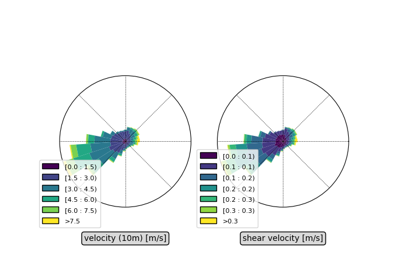pydune.data_processing.plot_wind_rose#
- plot_wind_rose(theta, U, bins, ax, fig, label_angle=False, label=None, props={'boxstyle': 'round', 'edgecolor': (1, 1, 1, 1), 'facecolor': (1, 1, 1, 0.9), 'pad': 0}, blowfrom=False, legend=False, **kwargs)[source]#
Plot a wind rose on the given axe of the given figure.
- Parameters:
theta (numpy array) – time series of the wind angle, in degree. Here, the angles show where the wind blows to, are anticlockwise and the 0 it a wind blowing to the East.
U (numpy array) – time series of the wind velocity.
bins (list) – velocity bin edges.
ax (matplotlib.Axes) – axe of the figure that will be replaced by the flux rose.
fig (matplotlib.figure) – figure on which the flux rose is plotted.
label_angle (bool) – if True, label the angles (the default is False).
label (str, None) – if provided, labels the flux rose with the given string (the default is None).
props (dict) – Bbox properties used around the label (the default is dict(boxstyle=’round’, facecolor=(1, 1, 1, 0.9), edgecolor=(1, 1, 1, 1), pad=0)).
blowfrom (bool) – If blow from, the rose will be \(\pi\)-rotated, to show where the fluxes come from (the default is False).
legend (bool) – If True, display a legend for the velocity bins (the default is False).
**kwargs (type) – any other optional parameters that can be passed to
windrose.WindroseAxes.bar.
- Returns:
return the axe on which the wind rose is plotted. Can be used for further modifications.
- Return type:
WindroseAxes
Examples using pydune.data_processing.plot_wind_rose#

From wind data to sand fluxes and dune orientations